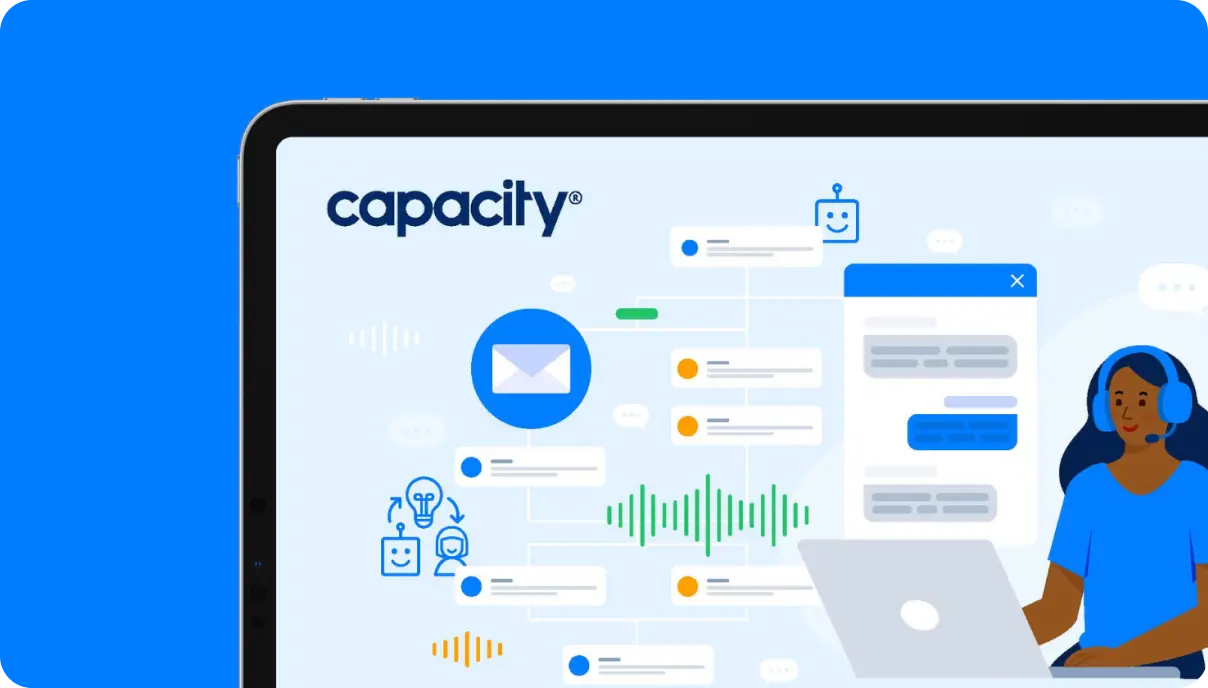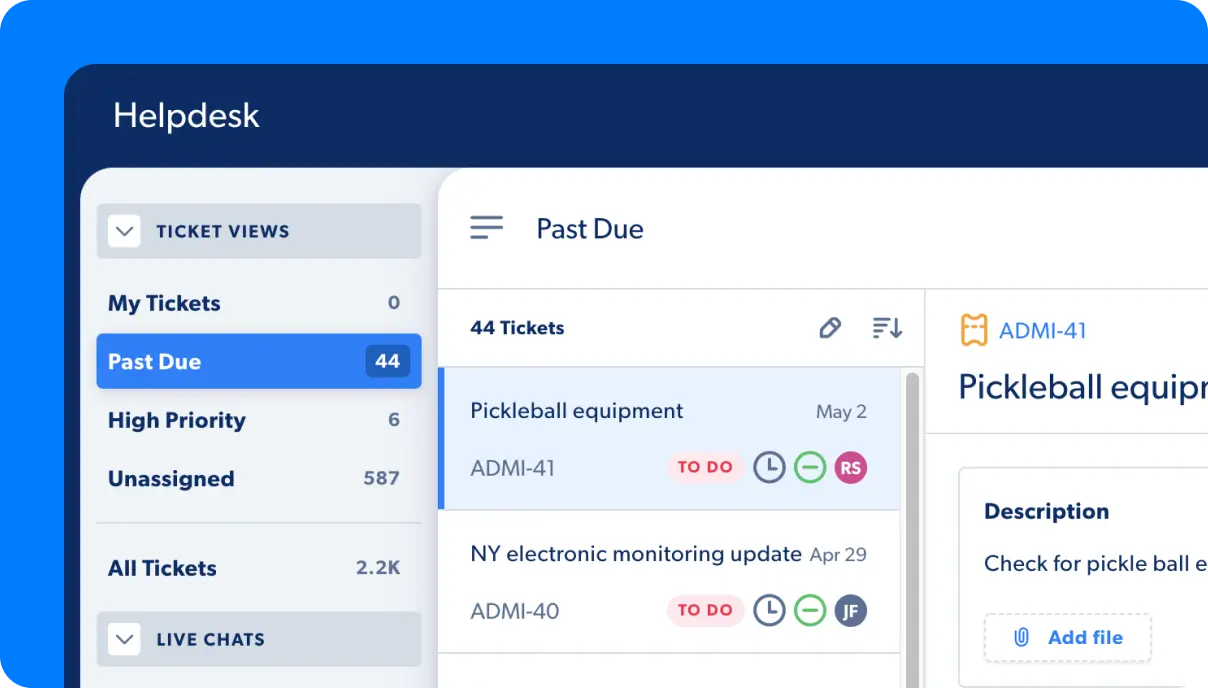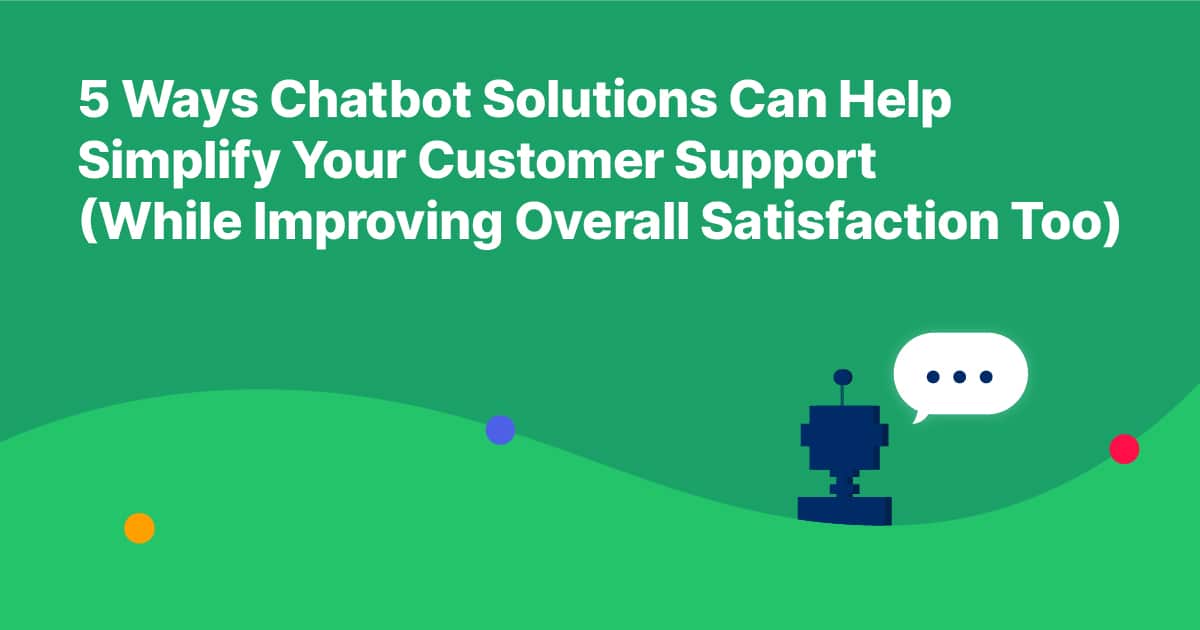Being in support is hard. Customers are finicky. Bosses are panicky. And our agents are all hungry (to help). But people don’t actually want help from agents. Not immediately, anyway. Studies show that 81% of customers try to take care of issues themselves before contacting an agent.
And while automation has played a role in the customer experience for a while now, we’ve reached a tipping point. Not only are intelligent machines on the verge of taking over, but customers clearly want them to. This is where AI chatbot solutions come in.
Chatbots reduce customer wait times by automating routine tasks and providing instant help. And that then leads to happier customers and improved satisfaction rates. They also let your agents focus on the more complex issues that need human expertise. That then strengthens your customer relationships and loyalty.
What’s more, AI chatbots have an incredible ability to learn and adapt. Because they’re backed by machine learning, they’re watching and learning from every interaction. As they find patterns and trends, they’re able to personalize their responses, just like a human would. And since they can instantly see and understand a customer’s history, they can make tailored recommendations. The result? Better customer experiences and increased conversion rates, as customers feel understood and valued by your brand.
What are AI chatbot solutions?
Just to be sure everyone is on the same page, let’s get started with a quick definition. AI chatbot solutions are conversational apps powered by AI and NLP. They let customers interact with businesses in a natural, comfortable way without needing a live agent.
AI chatbot solutions can understand customer queries. And they interpret intent, provide answers or recommendations, and even complete specific tasks.
5 ways AI chatbot solutions can help simplify your customer support
AI chatbot solutions can help simplify customer support in a variety of ways.
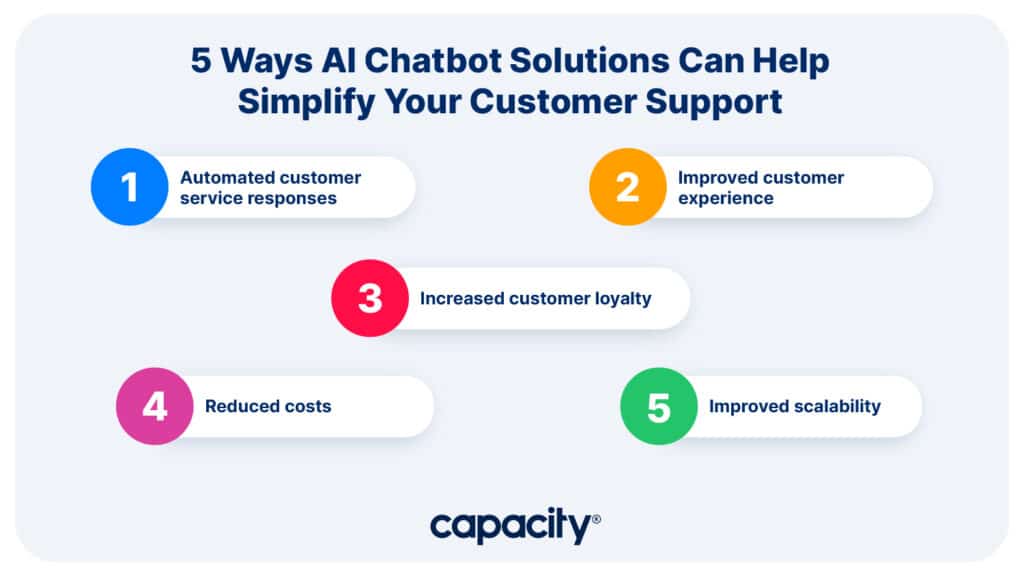
Here are five:
- Automated customer service responses. AI chatbots can quickly respond to basic customer queries, freeing up customer service agents to focus on more complex issues. And bots can answer FAQs, resolve simple cases, and answer repetitive questions. They can even complete specific tasks (like changing an email address).
- Improved customer experience. AI chatbots can provide customers with more personalized, intuitive, and efficient experiences. By understanding natural language queries and giving customized recommendations or automated solutions, customers can get the help they need quickly and easily.
- Increased customer loyalty. Chatbots can help build customer loyalty by providing a positive, efficient service experience. Customers are less likely to become frustrated when they get quick and accurate answers from an automated system than when waiting on hold for an agent.
- Reduced costs. AI chatbot solutions can reduce operational costs associated with customer support. By automating basic tasks, businesses can cut down on the need for a fully staffed center 24/7.
- Improved scalability. AI chatbot solutions let you scale support operations as needed. With automated responses, you can handle more inquiries without increasing staffing levels.
4 best practices in using AI-driven chatbots
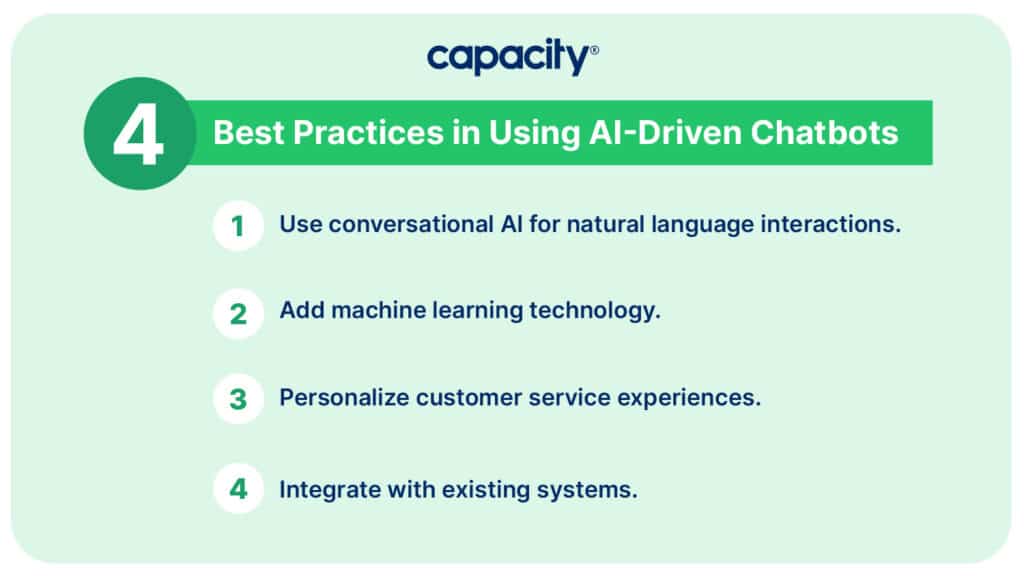
- Use conversational AI for natural language interactions. Adding conversations in the service process lets customers interact with chatbots using natural language rather than using specific keywords or phrases. This helps improve accuracy and can make it easier for customers to get the help they need.
- Add machine learning technology. Using machine learning can help ensure that your chatbot is providing accurate responses. And it can make sure it stays consistent as inquiries change over time.
- Personalize customer service experiences. Chatbots let you personalize experiences by gathering data from previous interactions. The bot can then make relevant, personalized recommendations based on the data.
- Integrate with existing systems. Properly integrating existing systems (CRM, billing, etc.) with your AI chatbot is essential in ensuring seamless operations across all customer support channels.

Automate Your Work
Capacity’s enterprise AI chatbot can help:
- Answer FAQs anytime, anywhere
- Find relevant documents within seconds
- Give surveys and collect feedback
4 standout AI-driven chatbot solutions
There are four standout AI-driven chatbot solutions on the market today. Each has its own set of features and advantages to consider:
- ChatGPT. ChatGPT is an AI-powered chatbot that you can use for a ton of use cases. For instance, customer service, marketing, and sales all have found value in the service. It’s powered by OpenAI’s GPT-4 language model, which makes it proficient in several language tasks, like writing, summarization, translation, and conversation. Moreover, it works like a search engine with information on current events.
- Capacity. Capacity is a chatbot platform that helps you automate your customer service and support. It uses AI to understand customer queries and provide answers in a human-like way. It uses both conversational and generative AI to simplify your experience. (And it makes it easy for customers to interact with you, too.) It’s available in several languages and can connect to a ton of systems, like your CRM, Slack, Teams, email, and the like.
- Bing Chat. Bing Chat is a chatbot developed by Microsoft designed to provide service and support to users. It’s backed by Microsoft’s AI technology, which lets it understand natural language and respond to user queries in a human-like way. Bing Chat is available in several languages. And often, you can connect it with your existing systems, too.
- Bard. Bard is a large language model from Google AI, trained on a massive dataset of text and code. It can generate text, translate languages, write different kinds of content, and answer questions. Bard is still under development. But it’s already learned all sorts of tasks that can be helpful for service and support teams.
8 questions to ask before purchasing a tool
Before you invest in a chatbot solution, you have to know the right questions to ask your vendors. After all, your vendor is going to be your partner, and your tech will fuel your experience. So, you have to know you’ll be set up for success.
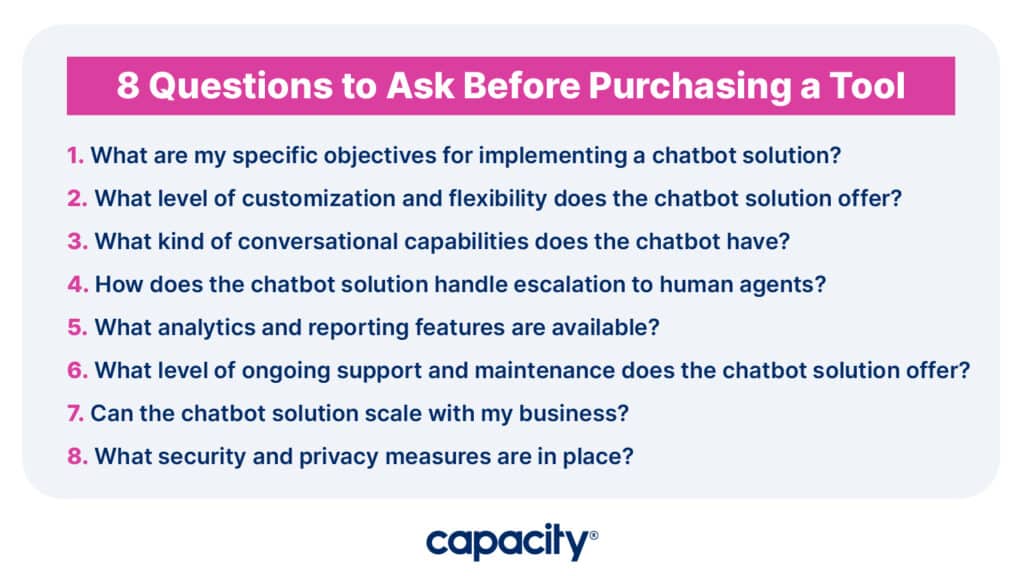
Here are a few crucial questions to consider:
1. What are my specific objectives for implementing a chatbot solution?
- Clarify your goals, whether it’s to automate routine tasks, improve response times, enhance customer satisfaction, or streamline support operations. Knowing your objectives will help you check how well a chatbot solution aligns with your goals.
2. What level of customization and flexibility does the chatbot solution offer?
- Determine if you can tailor the bot to your brand voice. It should use industry-specific terminology and customer support workflows, too. Ask about customization options, integration capabilities with existing systems, and flexibility to adapt as your needs evolve.
3. What kind of conversational capabilities does the chatbot have?
- Ask about the chatbot’s natural language processing (NLP) capabilities and its ability to understand user intent, handle complex queries, and provide accurate responses. Ask for examples of its conversational skills and how it learns and improves over time.
4. How does the chatbot solution handle escalation to human agents?
- Understand how the chatbot knows when to transfer a conversation to a human agent. Ask about the handoff process, the criteria for escalation, and how the chatbot can provide context and relevant information to agents for a smooth transition.
5. What analytics and reporting features are available?
- Inquire about the analytics and reporting capabilities of the chatbot solution. Ask about metrics like chatbot usage, customer satisfaction ratings, response times, and customer insights. Understanding how you can measure the effectiveness and impact of the chatbot is crucial for ongoing improvement.
6. What level of ongoing support and maintenance does the chatbot solution offer?
- Determine the support and maintenance services provided by the vendor. Ask about training, documentation, and technical support available during implementation and after deployment. Understand the vendor’s response time for bug fixes and updates.
7. Can the chatbot solution scale with my business?
- Consider your future growth plans and ask how the chatbot solution can accommodate increased user demand and expanding support requirements. Inquire about scalability options, such as handling high volumes of conversations and supporting several languages.
8. What security and privacy measures are in place?
- Understand the security protocols in place to protect customer data and ensure compliance with data privacy regulations. Ask about encryption, access controls, data retention policies, and how the vendor addresses security vulnerabilities and updates.
What are you waiting for? Try Capacity for free today and get started!
